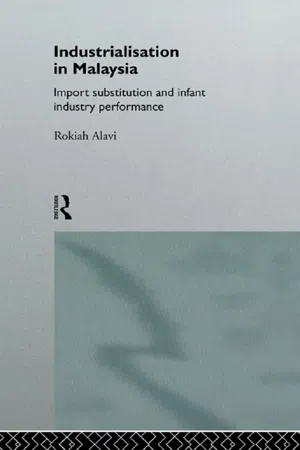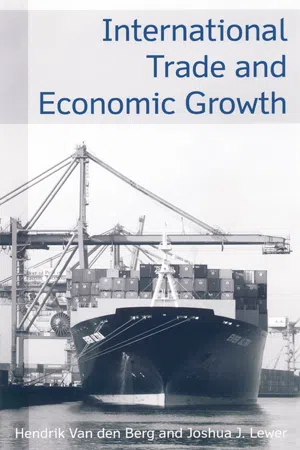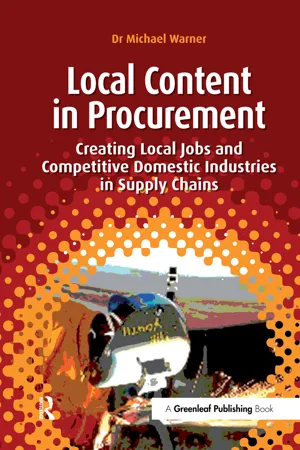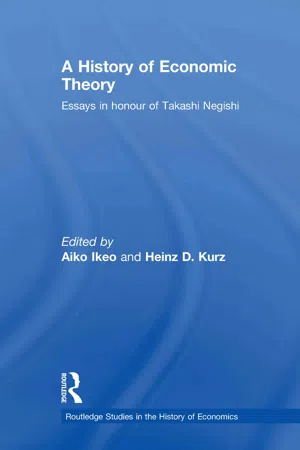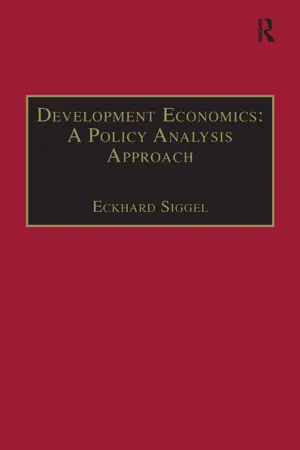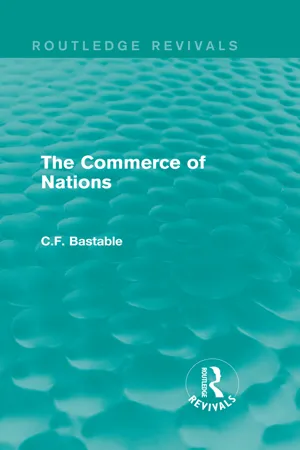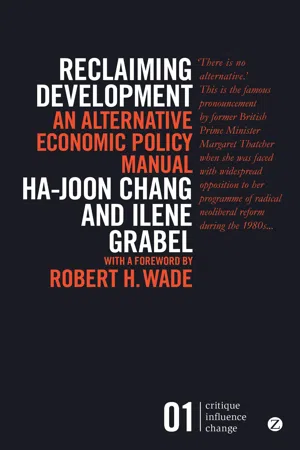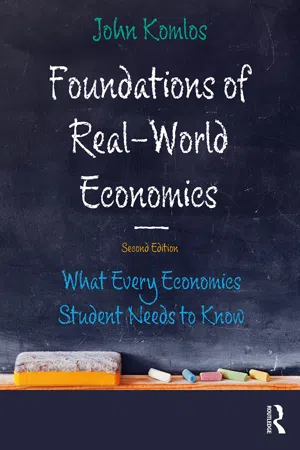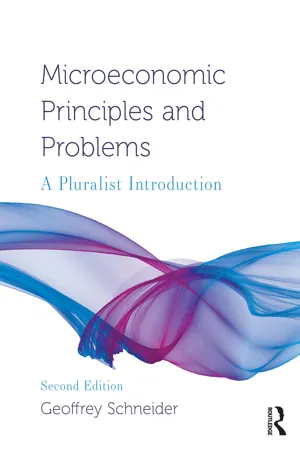Economics
Infant Industry Argument
The infant industry argument is an economic rationale for protecting and nurturing new and emerging industries within a country. It suggests that temporary trade barriers or subsidies can help these industries grow and become competitive in the global market. The goal is to enable these industries to reach a level of maturity where they can effectively compete without government support.
Written by Perlego with AI-assistance
Related key terms
Related key terms
1 of 4
Related key terms
1 of 3
12 Key excerpts on "Infant Industry Argument"
- eBook - ePub
Industrialization in Malaysia
Import Substitution and Infant Industry Performance
- Rokiah Alavi(Author)
- 2006(Publication Date)
- Routledge(Publisher)
The framework of this chapter is set so as to explain each of these propositions in detail. Thus, we begin with a discussion of the theory regarding infant industry protection for a basic understanding of the argument. Then we explain the first, second and third propositions. All analysts agreed that if these three propositions are valid, then some form of assistance to the activity is warranted. Therefore we examine briefly various recommendations by different analysts as to what are the best policy tools in promoting infant industries.Infant Industry Argument: THE THEORY
In theory, the Infant Industry Argument for protection is one of two exceptions allowed in classical economics for intervening in free trade; the other being the optimum tariff argument 1 (Johnson 1970). The gist of the Infant Industry Argument is that the present (static) cost of protection is accepted for the sake of future (dynamic) benefits, where under protection, the infant will experience faster productivity growth and could eventually compete in the domestic and world market (Weiss 1988). In other words, infant industry protection is a dynamic comparative advantage orientated policy (Schydlowsky 1984).The initial criterion for justifying protection for a firm or an industry is that there must be a gap between the average cost of production for domestic producers and that of world competitors. This gap is likely to be created by lack of experience, technological know-how and also by differences in the country’s history and stage of development. It has generally been assumed that new industries have little experience in terms of production techniques, management, marketing and other entrepreneurial expertise. These factors lead to inefficiency, and therefore new local producers are not able to compete with established and efficient world producers. Thus they are considered to be infants, relative to the grown-up, efficient and competitive industries in advanced industrial countries. The proponents of protection argue that if the industry were to be established, then it needs time and support to grow up under protection and gain the necessary experience to produce cost-efficiently.Hence, government intervention is necessary to allow local industries to compete with efficient and competitive producers from abroad. Protection will enable the local producers to reap the benefits of economies of scale in production resulting from a guaranteed domestic market. As output increases, scale economies would lead to declining costs of production and the industry to become efficient and competitive over time through learning by doing. Thus, the Infant Industry Argument rests on the promise of future productivity growth in the protected industries. This means that the industry must have positive and fast productivity growth over time. - eBook - ePub
- Hendrik Van den Berg, Joshua J Lewer(Authors)
- 2015(Publication Date)
- Routledge(Publisher)
Like all policies that target specific industries, the Infant Industry Argument also assumes that policy makers can accurately predict future comparative advantage. Krueger and Tuncer (1982) tested the Infant Industry Argument using data on India and Turkey, and they found no evidence that protection was in any way systematically related to firms that ultimately became competitive in international markets. Infant industry protection also raises the potential for foreign retaliation, especially by countries who have industries that currently enjoy the comparative advantage. World Trade Organization (WTO) rules do not permit government subsidies or protection to help domestic industries compete and gain world market share. If countries take a complaint to the WTO, it is likely to authorize countries to retaliate by restricting the import of products from the offending country.Despite all of the qualifications, however, it is nevertheless possible that there are individual firms or even whole sectors of an economy that qualify as infant industries . In developing economies the financial sector is often not well developed and unable to provide financing for long-term or large projects. Or, there may be external benefits from new industries that cannot be captured by the individual owners or the financial sector. Finally, governments may not have well-run tax systems that can cover the costs of direct subsidies to an infant industry; the indirect method of having consumers of imports effectively pay for the temporary cost of protection may be the most efficient way to bring a potentially profitable infant industry into existence. It should be clear, however, that the assumptions underlying the logic of the Infant Industry Argument are not general. The Infant Industry Argument applies to very special circumstances.7.5 Import Substitution PoliciesAfter World War II, many countries in Latin America, Africa, and Asia actively restricted international trade as part of what have come to be called import substitution - eBook - ePub
Local Content in Procurement
Creating Local Jobs and Competitive Domestic Industries in Supply Chains
- Michael Warner(Author)
- 2017(Publication Date)
- Routledge(Publisher)
social impact argument. These are discussed in turn below.Infant Industry Argument
The Infant Industry Argument was first espoused by Alexander Hamilton, a Founding Father of the United States and Secretary of the Treasury. Hamilton was an advocate of government intervention to support business in a fledgling country, and a strong opponent of free trade.3 The same argument continues today in many emerging and developing economies. The argument asserts that protectionism is acceptable where nascent industries do not yet have the economies of scale of foreign competitors, and thus need support (protection) until such a time as they can attain a similar level of competitiveness.Figure 1.3 Infant Industry ArgumentFigure 1.3 is a schematic showing how, under the Infant Industry Argument, limited protectionism is intended to lead over time to a domestic industry able to compete against international trade. It also shows what happens if the efforts of governments to intervene through education, training, sourcing preferences, capital investment, tax incentives and so on are unsuccessful (what is referred to as ‘double market failure’; see Box 1.2 - Koichi Hamada, Keijiro Otsuka, Gustav Ranis, Ken Togo(Authors)
- 2011(Publication Date)
- Routledge(Publisher)
2 Infant industry protection policyreconsidered The case of the automobile industry inJapan Ken Togo* 1 IntroductionInfant industry policy is a rarely heard term in advanced economies where most industries are mature. The term has also been forgotten – or intentionally shunned – by academics. The fact that many developing countries that adopted infant industry policies after World War II failed to develop their own industries led many people to think that an infant industry policy was not effective. The 1980s debt crisis in Latin America, where most countries had aggressive infant industry policies in place, strengthened the impression that an infant industry policy is harmful to growth. During the 1990s, mainstream economists concluded that an infant industry policy was undesirable.The most influential textbook on international economics, by Krugman and Obstfeld, states the argument against infant industry policy as follows:In practice it is difficult to evaluate which industries really warrant special treatment, and there are risks that a policy intended to promote development will end up being captured by special interests. There are many stories of infant industries that have never grown up and remain dependent on protection.(Krugman and Obstfeld 2003, p. 258)Although it may be difficult to identify potential industries, examples of successful infant industries do exist. Moreover, it may be possible to avoid capture by special interests through various schemes.Infant industry policy is defined as policy that “assists an industry in its early stages of development.” It includes not only protective tools, such as tariffs and import restrictions, but also promotion tools, such as subsidies and government procurement. Infant industry policy is a subset of industry policy, defined here as policy that has some effects on industry. Import substitution policy is policy that protects domestic production that competes with imported goods. If the infant industry is an industry that produces goods that are substitutes for imported goods, the policy is an import substitution policy.- eBook - ePub
- Aiko Ikeo, Heinz D. Kurz(Authors)
- 2009(Publication Date)
- Routledge(Publisher)
Corden (1965: 62–5) was sympathetic to the argument for infant industry protection because he thought the critics like Kemp did not use models appropriate for underdeveloped countries. Corden kept emphasizing the importance of external economies expected to generate from protected infant industry. Corden (1974: 256–7) paid attention to the argument in Negishi (1968) and extended it by using the concept of the pecuniary external economies (producers’ and consumers’ surplus) which result from indivisibility or ‘lumpy’ investment in learning based on dynamic internal economies. Economists like Max Corden remain sympathetic to protectionist policies, although he admitted that he believed in free (freer) trade (Coleman 2006: 388). 17 In spite of the theoretical argument, we should admit several problems occurring in reality. It is true that Infant Industry Argument has been often abused, and that there is often a problem of implementation and a difficulty in ending the policy. The test for lifting the protection should be that if a protected industry develops to the point where it can compete in the world markets, as many have, it has grown up (Kindleberger 1958: 216–7). Several economists list negative examples. Kindleberger (1958: 216) suggested that the US pharmaceutical industry had operated on an export basis but behind a wall of protection after World War I. Anne O. Krueger and B. Tuncer (1982) made an empirical case study of Turkish protected industries and argued against infant industry protection (Krueger 1984). Yet the US has been the richest country in the world. Turkey is one of the 20 original members of OECD and should fall into the category of a developed country - Eckhard Siggel(Author)
- 2016(Publication Date)
- Routledge(Publisher)
Even without the concern with terms of trade deterioration and export instability, a further argument in favour of trade restrictions is based on the fundamental objective of industrialization, combined with the need for protection of infant industries. The goal of industrialization relies on the promise of higher productivity levels and growth, higher incomes and urban living standards, which are known to accompany industrialization. Since industries are not easily developing in an environment of fierce international competition, industrialization requires infant industry protection. The theory is that by temporarily increasing the price of competing imports of manufactured goods through import taxes, new and existing domestic firms are enticed to invest, to ‘learn by doing’ and to produce at larger scale, until they are efficient enough to face international competition. Since in this strategy former imports are replaced by domestic production, the process is called import substitution or import-substituting industrialization (ISI).The argument in favour of infant industry protection is based on the assumptions of cost-lowering learning effects and of economies of large-scale production and of positive external effects related to learning. External benefits exist, if the whole economy benefits above and beyond the benefits accruing to the protected firms, such as improved skills of the labour force. If the protection of industries always led to efficient domestic competitors, the strategy of import substitution would not have attracted so much criticism; but industrial protection tends to become permanent and to spiral into a vicious circle of rewards for non-competitiveness. To see how this happens, we shall examine the policy instruments of inward-oriented trade regimes and their effects on producers and consumers.Finally, it can also be argued that even without long-run terms of trade decline and export instability, free trade offers no guarantees for gains, because international prices tend to be distorted as a consequence of other countries’ policies or of market imperfections. For instance, the international price of various agricultural commodities such as sugar, are known to be artificially low as a consequence of protection and/or subsidization by the rich countries. This prevents countries whose natural comparative advantage may lie, for instance, in sugar production, to realize gains from exporting sugar, or even from producing it for their own markets. The existence of such distortions and various protective policies on behalf of trading partners has led developing country governments to a more protective attitude than they would have adopted otherwise.- C.F. Bastable(Author)
- 2016(Publication Date)
- Routledge(Publisher)
Chapter XIII Economic Arguments for Protection I N arranging the various pleas urged in favour of the protective system, it is desirable to take those that have had serious influence on policy and that possess real importance, before noticing contentions that rest on some exploded fallacy or appeal to vulgar prejudices. A system may fairly claim to be judged by its strongest positions. Taking this rule as our guide, we proceed to examine the more important of the arguments, some of which we have already noticed in considering the general features of protectionism. I. Protection aids Young Industries.—By far the most effective of the arguments used by the protectionists, as distinct from those surviving from the days before Adam Smith, is that which asserts that new industries stand in need of protection from foreign competition. We have seen (pp. 129-30) how it was employed by Hamilton, and in a wider sense by List. For a long period it was the standing plea of American protectionists; it has, moreover, received the qualified approval of J. B. Say and Mill, and is repeated in numerous German text-books of economics. Stated shortly, the argument is—The commencement of an industry is beset with difficulties which reach their maximum when the attempt has to be made in a country hitherto entirely destitute of anything resembling the particular form of production. The co-ordination of the various agents of production into an “establishment” or “factory” is a process requiring time, and not likely at first to be remunerative. Besides, in an occupation not previously known, the supply of labour suited for the industry is at first wanting. The enterprising manufacturer has to contend against this and similar obstacles; on the other hand, there is no assured market for the product. The weight of reputation and the advantages that organization and a ready supply of the requisite forms of labour and capital give are on the side of the older producers- eBook - ePub
International Trade
New Patterns of Trade, Production and Investment
- Nigel Grimwade(Author)
- 2020(Publication Date)
- Routledge(Publisher)
Recently, a new debate has begun concerning the merits or otherwise of government intervention in international trade with the emergence of the so-called 'new trade theory'. A number of models of trade have been developed which show that, contrary to what has been 'received wisdom' for a century more, there are certain circumstances in which government in trade can be beneficial. Hitherto, most economists regarded the optimum tariff argument as the only theoretically sound argument for government intervention in trade. Even this was regarded as having a relatively limited application and subject to a large number of constraints. The new trade theorists, however, have argued that government intervention in trade may be more beneficial than economists have often assumed. The case is applicable to industries in which the normal assumptions of perfect competition do not apply and where the market is dominated by a comparatively small number of large firms. These are industries in which there exist substantial entry barriers that prevent new firms from competing away any excess profits that the existing firms may enjoy. A particular form of entry barrier is the existence of high fixed or start-up costs, such that average cost falls sharply with the volume of output. New firms entering the industry face much higher average costs than established firms, which renders entry unprofitable.Box 8.4 Theoretical Arguments for Protection- Optimum Tariff Argument - applicable only to a large importing nation with monoposonistic power, assumes importing country possesses sufficient information to impose an optimum tariff and assumes no foreign retaliation.
- Competitive Distortions- tariffs are always inferior to domestic taxes/subsidies for correcting distortions caused by the occurrence of externalities.
- Infant Industry Argument -
- eBook - ePub
Reclaiming Development
An Alternative Economic Policy Manual
- Ha-Joon Chang, Ilene Grabel(Authors)
- 2014(Publication Date)
- Zed Books(Publisher)
The country’s experience should serve as a powerful warning for other countries within the Americas that are considering participating in US President Bush’s plan to extend the NAFTA southward in the proposed Free Trade Area of the Americas (FTAA). Mexico’s experience suggests that developing countries should consider their trade relations with industrialized countries quite carefully. If such trade is to occur, it is imperative that developing countries manage it carefully through the selective use of tariffs and other trade protections and supports (see also Chapter 7.2). Infant industry theorists argue that developing countries should promote patterns of production (and specialization) that foster long-term economic development. The Infant Industry Argument has a rather long and distinguished lineage. It was first successfully put into practice in Britain following the 1721 trade policy reform of Robert Walpole, the first British Prime Minister. However, it was the first US Treasury Secretary, Alexander Hamilton, in 1791 who first systematically developed the argument. Following Hamilton, many economists and politicians (among them Abraham Lincoln) in the nineteenth-century USA vigorously contested the British doctrine that free trade is good for all countries and argued that new industries in a less developed country (e.g. the USA at the time) required tariff and other protection in order to develop in the face of stronger competitors from the more advanced countries (e.g. Britain). One US congressman famously remarked in the 1820s that English trade theory, ‘like most English manufactured goods, is intended for export, not for consumption at home’. German economist Friedrich List developed the most sophisticated and forceful elaboration of the Infant Industry Argument in the 1840s after a period of exile in the USA in the 1820s, where he was exposed to Hamilton’s argument - eBook - ePub
The WTO and Infant Industry Promotion in Developing Countries
Perspectives on the Chinese Large Civil Aircraft
- Juan He(Author)
- 2014(Publication Date)
- Routledge(Publisher)
1 The following sub-sections, however, reveal that this broad-based development strategy is actually at odds with the policy experiences of most of today’s advanced economies. For these early developed countries, the model for stimulating prioritized industries used to rest on a long list of regulatory incentives and institutional arrangements, rather than laissez faire policies. Generous and sustained public support was successful in setting off the growth period of many key infant industries, primarily in targeted manufacturing areas. Moreover, economies at a similar development stage had in place a series of policies which bore partial resemblance to one another. Such stimulating measures applied widely before the WTO came into existence, could be classified into three main groups: (1) import-substitution practices innovated by early industrialized countries while facing little multilateral constraint; (2) import substitution followed by Latin American countries which began to conflict ideologically with the liberalization rules of the GATT 1947; and (3) export promotion policies employed by East Asian emerging economies, as represented by South Korea and Taiwan, to realize the export potential of emerging local businesses.2.2 Import-substituting industrialization
Import substitution is a long-established industrialization strategy which advocates the use of trade restrictions, predominantly tariffs and import quotas, to encourage the replacement of imports by local industries oriented towards a domestic market.2 The Infant Industry Argument constitutes the primary driving force for the rise of import-substitution industries in many early developed countries. In the history of trade policy theory, the concept of import substitution was formalized as late as the 1950s.3 In practice, it derived a rough skeleton from a much earlier time in the United Kingdom (UK). Starting from the fourteenth century, the country began to design and implement import-substitution policies when motivated by the enterprise of building up a local woollen industry. Starting from an agricultural economy, the government of the UK gradually regarded labour-intensive manufacturing as the focus of technologically advanced industry in that era. Its preferred policies included selectively high tariffs, taxing raw wool exports, poaching skilled workers from the more advanced Netherlands and Belgium and so on.4 Before the UK became the world’s dominant economic power in the late eighteenth century, the country had progressively established a group of basic manufacturing, including, inter alia, wool, cotton, iron and other metals, shipbuilding and fisheries, ‘behind high and long-lasting tariff barriers’.5 Its weighted average of industrial tariffs had long been maintained in a range between 45 per cent and 55 per cent until the 1820s, which thus ranked it the foremost protected economy among European nations.6 - eBook - ePub
Foundations of Real-World Economics
What Every Economics Student Needs to Know
- John Komlos(Author)
- 2019(Publication Date)
- Routledge(Publisher)
Even if international trade were to increase welfare and not cause unemployment, and if losers were fully compensated by the gainers, there is nothing in the theorem of comparative advantage that predicts that economic growth would accelerate in the wake of free trade. That depends on whether the gains are spent or invested. The Chinese were able to translate their gains into growth because they invested their profits, whereas the U.S. bought consumer goods that have no lasting growth effects. The cheaper shirts bought decades ago are no longer around, whereas the Chinese capital investments are still generating returns.The Protection of Infant IndustriesIn the early stages of economic development industrial growth is fostered by subsidizing infant industries or by protecting them with tariffs. For example, suppose computers have just been invented in country A and a firm can produce them for $100. As it starts manufacturing them it accumulates knowledge about how to build them more cheaply—called learning by doing—and by next year can build them for $95. Now firms in country B see the opportunity but do not have the specific knowledge on the best practices, so they would have to start the process as a higher-cost producer at $100. So producers in country A enjoy a “first-mover advantage” and producers in country B will only produce computers if the government provides a $5 subsidy or levies a tariff of $5 on computers. First-mover advantage means that follower countries have to play catch-up and free trade would not work to their advantage. In this case country B would never be able to produce computers without protection. A current example is the penetration of the Chinese wind turbine manufacturers into the U.S. market, to the detriment of the fledgling home industry.11Unbalanced Trade Creates UnderemploymentIn the real world the existence of money and IOUs mean that exports and imports do not have to equal as they do on the blackboard: the U.S. balance of payments has been negative continuously since 1976 (Table 13.1 ). The floodgates were opened in 1980 with the endemic budget deficits.12 Then came two turning points: The North American Free Trade Agreement13 (NAFTA) in 1994 and China’s joining the Word Trade Organization (WTO) in 2001. In their wake, the deficits almost doubled and then more than doubled again after 2002. In 2006, they peaked at $761 billion and then settled down to just over $500 billion after the recession14 (Figure 13.3 - eBook - ePub
Microeconomic Principles and Problems
A Pluralist Introduction
- Geoffrey Schneider(Author)
- 2024(Publication Date)
- Routledge(Publisher)
Supply-side economists focus primarily on business profits, arguing that the government should work to give domestic companies advantages and disadvantage foreign competition, usually via tariffs. This was the approach taken during the Trump administration in the U.S. from 2017–2020. However, without the other types of support noted above, this approach had limited impact in rejuvenating U.S. manufacturing. Recently, these criticisms of unregulated trade and the theory of comparative advantage have gained traction, and in the last decade countries moved increasingly away from free trade. Most developed countries now utilize a significant degree of protectionism. 24.4 PROTECTIONISM: USING TARIFF AND NON-TARIFF BARRIERS TO PROTECT INDUSTRIES The main policies a country can use to protect specific industries are tariffs and quotas. A tariff is a tax on imported goods. An import quota is a limit on the quantity of a good that can be imported. Other policies a country can use to protect industries include subsidies and laws or regulations that prevent or impede trade. There are a number of reasons why a country may want to protect some of its industries: Infant industry protection: As noted above, one of the strongest reasons to protect an industry is to foster economic development. New industries usually need protection until they gain the size and experience necessary to compete at the international level. Strategic industry protection: Certain industries may be deemed so essential to a country’s interests that they cannot be entrusted to production in foreign locations. Typically, industries associated with national defense fall within this category. The United States has protected its steel, electronics, and metalworking industries for national defense reasons. Similarly, certain industries are essential for clusters of economic development. The U.S
Index pages curate the most relevant extracts from our library of academic textbooks. They’ve been created using an in-house natural language model (NLM), each adding context and meaning to key research topics.
Explore more topic indexes
Explore more topic indexes
1 of 6
Explore more topic indexes
1 of 4
